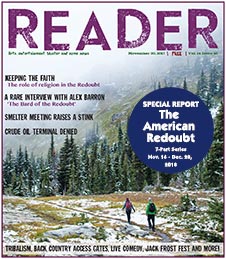Trail Dispatches: Trails for Health
By Deb Ruehle
Reader Contributor
“Live in each season as it passes; breathe the air, drink the drink, taste the fruit, and resign yourself to the influence of the earth.” — Henry David Thoreau
Nicole Grimm, a certified family nurse practitioner in Sandpoint, observes, “Physical activity is one of the most effective steps people can engage in to improve their overall health. … There is no more powerful medicine known to mankind than diet and exercise.” Grimm often prescribes lifestyle changes before any medication, and one of her favorite recommendations is to walk in nature for 30 minutes a day.
According to Grimm, “Physical activity has numerous health benefits — it helps to prevent heart disease, lowers blood sugar levels, reduces blood pressure, boosts bone density, strengthens muscles, improves balance, promotes weight loss and positively impacts mood. Exercising in nature can greatly reduce stress, calm anxiety and reduce the risk of depression.”
There is a movement toward “prescribing nature” in the health care industry, as demonstrated by Grimm and organizations like Park Rx America, a nonprofit whose mission is to decrease the burden of chronic disease, increase health and happiness, and foster environmental stewardship. Park Rx works closely with land managers and health care professionals to “make it easy” to prescribe parks and other protected areas to their patients in clinical-practice settings. Spending time in natural environments increases physical activity and stimulates the parasympathetic autonomic nervous system, thereby decreasing the risk of developing chronic diseases.
Easily accessible trails are also important for children and teens. Richard Louv wrote about what he called nature-deficit disorder in his 2005 book, Last Child in the Woods. The most common health conditions affecting youth, he said, are obesity, stress, anxiety and depression, particularly among teenagers. Louv cites about 60 studies looking at the benefits of nature and the problems that can come from being too isolated from the natural world. Spending time in nature, Louv concludes, can improv teens’ cognitive function; mental, social and emotional health; academic performance; and motor function.
Veterans with PTSD are also finding nature to be a tool for mental health recovery. Some legislators are even attempting to write nature therapy into federal law. Introduced in May, House Resolution 2435 “requires the Secretary of Veterans Affairs to establish an interagency task force on the use of public lands to provide medical treatment and therapy to veterans through outdoor recreation.” Outdoor recreation provides veterans struggling with combat-related injuries or post-traumatic stress with powerful therapeutic and healing experiences.
With the opening of Pine Street Woods this summer and the development of Sandpoint’s 4,200-acre watershed included in the city’s parks, recreation and open spaces master plan, trails are becoming increasingly accessible in Sandpoint’s frontcountry.
Pine Street Woods already offers an ADA-compliant trail, giving those for whom a stroll in the woods until now would have been difficult, if not impossible, access to nature right on the edge of town.
The physical, emotional and social health of our community depends on access to nature, and trails provide a path into the outdoors that people of all ages desire.
Deb Ruehle serves the Sandpoint community as a physical therapist and a city councilperson.









 Coming up this week! Don’t miss Live Music, the Summer Sampler, the Art Party, Monarch Grind, the Sandpoint Renaissance Faire, and more! See the full list of events in the
Coming up this week! Don’t miss Live Music, the Summer Sampler, the Art Party, Monarch Grind, the Sandpoint Renaissance Faire, and more! See the full list of events in the 